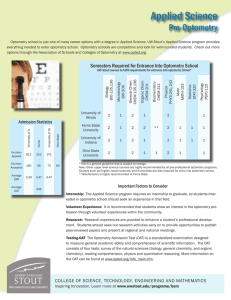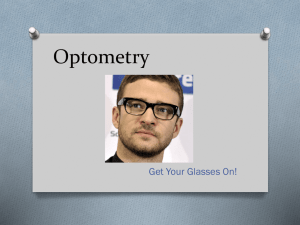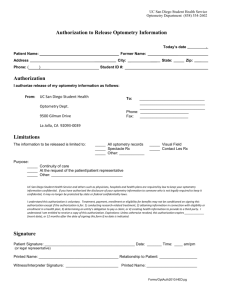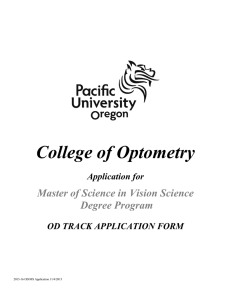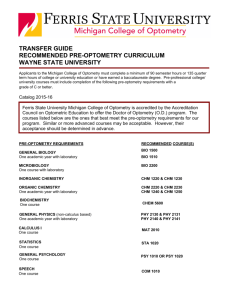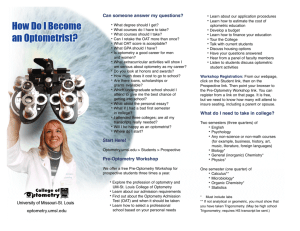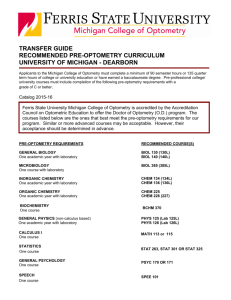A C R
advertisement
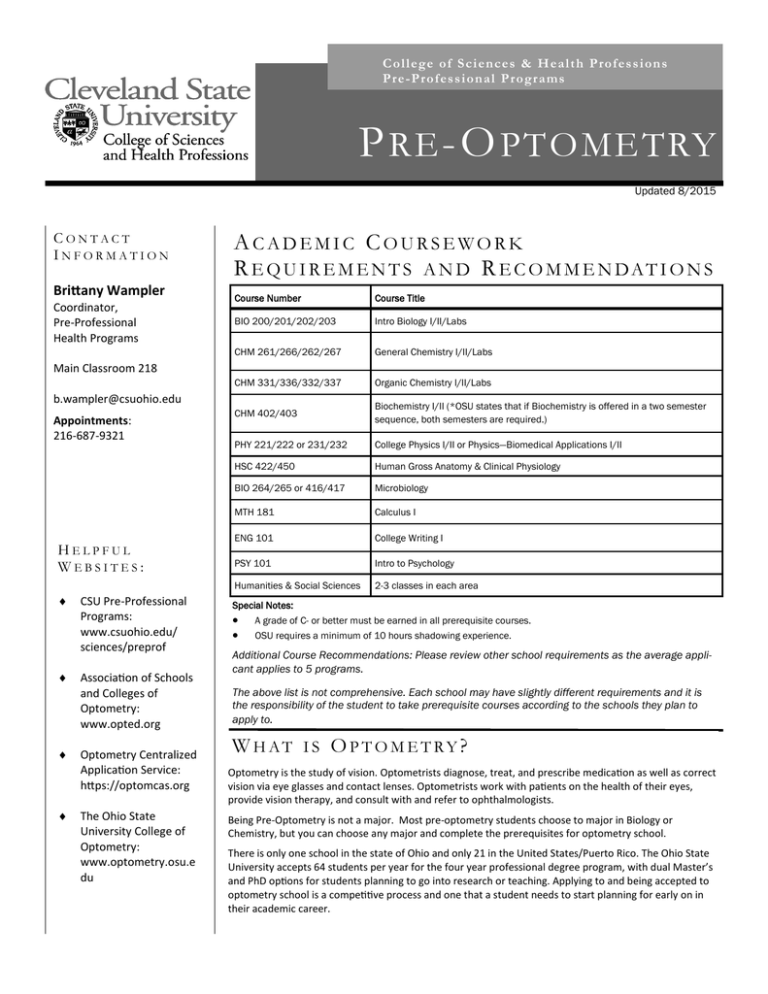
C o l l eg e o f S ci en ces & H eal t h Pro f es s i on s Pre -Pro f es s i o n al Pro g rams P RE -O PTOMETRY Updated 8/2015 CONTACT INFORMATION Brittany Wampler Coordinator, Pre-Professional Health Programs ACADEMIC COURSEWORK R E QU I R E M E N T S A N D R E C O M M E N DAT I O N S Course Number Course Title BIO 200/201/202/203 Intro Biology I/II/Labs CHM 261/266/262/267 General Chemistry I/II/Labs CHM 331/336/332/337 Organic Chemistry I/II/Labs CHM 402/403 Biochemistry I/II (*OSU states that if Biochemistry is offered in a two semester sequence, both semesters are required.) PHY 221/222 or 231/232 College Physics I/II or Physics—Biomedical Applications I/II HSC 422/450 Human Gross Anatomy & Clinical Physiology BIO 264/265 or 416/417 Microbiology MTH 181 Calculus I ENG 101 College Writing I PSY 101 Intro to Psychology Humanities & Social Sciences 2-3 classes in each area Main Classroom 218 b.wampler@csuohio.edu Appointments: 216-687-9321 HELPFUL WEBSITES: CSU Pre-Professional Programs: www.csuohio.edu/ sciences/preprof Association of Schools and Colleges of Optometry: www.opted.org Optometry Centralized Application Service: https://optomcas.org The Ohio State University College of Optometry: www.optometry.osu.e du Special Notes: A grade of C- or better must be earned in all prerequisite courses. OSU requires a minimum of 10 hours shadowing experience. Additional Course Recommendations: Please review other school requirements as the average applicant applies to 5 programs. The above list is not comprehensive. Each school may have slightly different requirements and it is the responsibility of the student to take prerequisite courses according to the schools they plan to apply to. WH AT IS OP TO M ETRY? Optometry is the study of vision. Optometrists diagnose, treat, and prescribe medication as well as correct vision via eye glasses and contact lenses. Optometrists work with patients on the health of their eyes, provide vision therapy, and consult with and refer to ophthalmologists. Being Pre-Optometry is not a major. Most pre-optometry students choose to major in Biology or Chemistry, but you can choose any major and complete the prerequisites for optometry school. There is only one school in the state of Ohio and only 21 in the United States/Puerto Rico. The Ohio State University accepts 64 students per year for the four year professional degree program, with dual Master’s and PhD options for students planning to go into research or teaching. Applying to and being accepted to optometry school is a competitive process and one that a student needs to start planning for early on in their academic career. ABBREVIATED TIMELINE FRESHMAN YEAR Maintain a strong GPA. Attend pre-health meetings on campus to get involved. Get to know professors in early biology and chemistry courses. Explore careers in optometry and develop Plan B options through extensive research. SOPHOMORE YEAR Maintain a strong GPA. Pursue meaningful experiences through related activities, including shadowing experiences. Develop relationships with faculty, mentors, and optometrists that could serve as references. JUNIOR YEAR Maintain a strong GPA. Consider who you will ask for letters of reference and schedule meetings to ask them specifically. Write your Personal Statement and have at least 3 people review it. Plan a timeline/study schedule for the OAT and sign up for a test date during the spring or summer. Familiarize yourself with OPTOMCAS application site, instructions, and processes. SENIOR YEAR Maintain a strong GPA. Continue to pursue meaningful experiences related to optometry. Complete the application process through OPTOMCAS, including secondary applications. Prepare for interviews. A P P LY I N G T O O P T O M E T RY S C H O O L The application process to optometry school is a rigorous one. Being that there are only 21 optometry schools in the country, students need to be competitive in order to get admitted. centralized system where students complete the first application. Application deadlines are set by the institutions. It is important to follow all directions and deadlines carefully. The accepted entrance exam to optometry school is the Optometry Admission Test (OAT). The OAT tests for academic ability and knowledge in four sections: natural sciences, (biology, chemistry, organic chemistry), physics, quantitative reasoning, and reading comprehension. Scores range from 200 to 400 and OSU states that the average score is 310330 per section. The actual application itself contains many parts. You should start as early as possible to give yourself as much time as possible to complete the application. All schools use the OPTOMCAS system for applications. It is a Below are the main components of the application: Academic Record/ Transcripts Extracurricular/Work Experience/Publications OAT Test Scores Personal Statement (4500 character limit) 3 Letters of Reference After you submit your application, you will be expected to complete any secondary applications for the individual institutions that you applied to. Schools will then invite you to interview. You will be expected to discuss your motivation for veterinary medicine, personal/ professional goals, and assessment of current health issues. You can get help with all areas of the application through the College of Sciences and Health Professional Pre-Professional Programs. GAINING EXPERIENCE Student organization involvement/leadership, volunteer work, research experience, job shadowing— there are so many options when it comes to creating a wellrounded resume. In addition to the coursework, optometry schools want to see wellrounded and committed applicants. OSU Optometry School requires at least one letter of reference from a current optometrist and therefore shadowing is paramount. You must shadow in two different types of practices as well. What is the best way to find someone to shadow? Please see the helpful tips below for tips and tricks when it comes to finding an optometrist to shadow. If you have a relationship with your family optometrist, start by asking that person! Conduct an online search of in the area or contact OSU for information about optometrists in your area. Call the office and get an email address so you can send a professional email (in the form of a shortened cover letter) along with your resume. When you email, make sure to state your intent. How long do you want the shadowing experience to last? What do you hope to achieve through the experience? Treat any interaction like an interview. Be professional at all times. Even if the optometrist says no or not at this time, thank them and let them know you would like to shadow in the future if an opportunity arises. Please keep in mind, you need to be successful in the classroom while also seeking out the opportunities you find to be most rewarding. There is no specific recipe for success in this area and you need to be selective in what you do to add to their application. Make sure to plan carefully and early. Also, think about how the people you meet through all of your experiences could help you as you apply to schools. You never know who you interact with that can have a positive (or negative) impact on your candidacy for optometry school. If you have additional questions about shadowing or other experiences, visit the Coordinator for Pre-Professional Health Programs !
